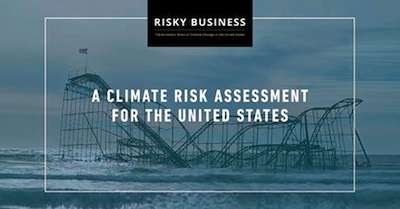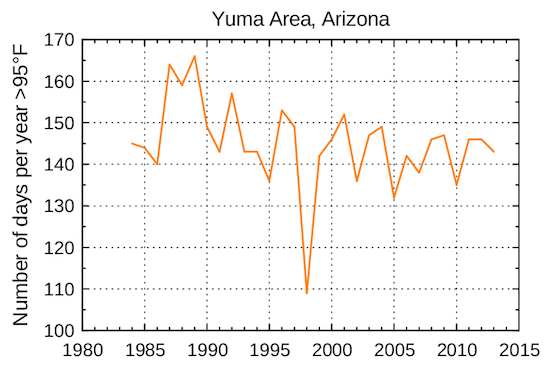
The
Risky Business Project led by Michael Bloomberg, Henry Paulson, and Tom Steyer recently released its report on "The Economic Risks of Climate Change in the United States." The project's co-chairs have all been out in the media promoting the project's report, and -- like sheep -- the mainstream media have generally been uncritical of the report's claims.
A core concern repeated throughout the Risky Business report is the predicted massive increase in what are termed "extremely hot days" (defined as days with a temperature exceeding 95°F) throughout the United States over the coming century due to anthropogenic climate change, and the resulting negative impacts of these increasingly numerous "extremely hot days" on the American economy.
Here are selections from the Risky Business report on the topic of extremely hot days:
"By the end of the century, Oregon, Washington, and Idaho could well have more days above 95°F each year than there are currently in Texas ...
The Southeast will also likely be hit hardest by heat impacts. Over the past 30 years, the average resident of this region has experienced about 8 days per year at 95°F or above. Looking forward, if we continue on our current emissions path, the average Southeast resident will likely experience an additional 17 to 52 extremely hot days per year by mid-century and an additional 48 to 130 days per year by the end of the century. That's one and a half additional months of extreme heat each year.
This kind of weather could have serious economic impacts: Our research shows a decrease in labor productivity in high-risk sectors like construction, mining, utilities, transportation, agriculture and manufacturing of up to 3.2 percent by the end of the century in this region, and a smaller but still noticeable impact on labor productivity in low-risk sectors like retail trade and professional services.
We are also likely to see an additional 15 to 21 deaths per 100,000 people every year in this region over the course of the century due to increases in heat-related mortality, with urban residents at greater risk due to the heat island effect. At the current population of the Southeast, that translates into 11,000 to 36,000 additional deaths per year ...
In the southern states of the Great Plains region (Texas, Oklahoma, and Kansas), our research shows an increase in extremely hot days. The average resident of these states experienced 39 days per year over 95°F in the past 30 years. This number will likely increase by 28 to 60 additional extremely hot days by mid-century and 60 to 114 days per year by the end of the century -- for a total of between three and four months of additional extreme hot days per year ...
The average Northwest resident will likely go from experiencing only 5 days of 95°F or warmer temperatures per year on average for the past 30 years to an additional 7 to 15 extremely hot days by mid-century, and to an additional 18 to 41 extremely hot days by the end of the century. This represents an increase of 3 to 8 times the number of hot days for the region per year, which is a significant change from historic norms ...
Over the past 30 years, the average Southwest resident experienced 40 days per year of temperatures of 95°F or more. If we continue on our current path, by mid-century the average Southwest resident will likely see 13 to 28 additional extremely hot days. By the end of the century, this number will likely rise to an additional 33 to 70 days of extreme heat due to climate change. That translates to one to two additional months of days over 95°F each year within the lifetime of babies being born right now in this region -- one of the fastest-growing in the United States."
This sounds terrible. Mass death, destruction, and economic loss all because of exponential increases in the number of extremely hot days across the United States of America compared to what we've seen over the past three decades.
This led me to examine trends -- or the lack thereof -- in the number of extremely hot days in these regions "over the past 30 years." Here are the results.

So only 11 percent of the 212 climate sub-regions have statistically significant increasing trends in the number of extremely hot days over the past 30 years -- a period of time during which greenhouse gas concentrations in the atmosphere have been increasing rapidly, and during which the impacts of anthropogenic global warming should be most evident.
Neither the Midwest nor Northeast have any sub-regions with significant increasing trends. And in the Southeast, where the Risky Business report predicts literally tens-of-thousands of people will be dying each year due to anthropogenic climate change caused extreme heat related mortality during the 21st century, only 6 percent of the sub-regions have an increasing trend.
The region in and around Yuma, Arizona has what appears to be the most days above 95°F each year -- at present -- in the United States, and Arizona is projected to be ground zero for climate change induced extreme heat problems. Here are the number of extremely hot days per year in the Yuma area over the past three decades.

See an increasing trend? Certainly not. Actually, there is nearly a statistically significant declining trend (p~0.1).
As with the National Climate Assessment, there appears to be a major disconnect between predictions of extreme heat catastrophe in the Risky Business report and the actual climate trends we see in recent decades.

 So only 11 percent of the 212 climate sub-regions have statistically significant increasing trends in the number of extremely hot days over the past 30 years -- a period of time during which greenhouse gas concentrations in the atmosphere have been increasing rapidly, and during which the impacts of anthropogenic global warming should be most evident.
Neither the Midwest nor Northeast have any sub-regions with significant increasing trends. And in the Southeast, where the Risky Business report predicts literally tens-of-thousands of people will be dying each year due to anthropogenic climate change caused extreme heat related mortality during the 21st century, only 6 percent of the sub-regions have an increasing trend.
The region in and around Yuma, Arizona has what appears to be the most days above 95°F each year -- at present -- in the United States, and Arizona is projected to be ground zero for climate change induced extreme heat problems. Here are the number of extremely hot days per year in the Yuma area over the past three decades.
So only 11 percent of the 212 climate sub-regions have statistically significant increasing trends in the number of extremely hot days over the past 30 years -- a period of time during which greenhouse gas concentrations in the atmosphere have been increasing rapidly, and during which the impacts of anthropogenic global warming should be most evident.
Neither the Midwest nor Northeast have any sub-regions with significant increasing trends. And in the Southeast, where the Risky Business report predicts literally tens-of-thousands of people will be dying each year due to anthropogenic climate change caused extreme heat related mortality during the 21st century, only 6 percent of the sub-regions have an increasing trend.
The region in and around Yuma, Arizona has what appears to be the most days above 95°F each year -- at present -- in the United States, and Arizona is projected to be ground zero for climate change induced extreme heat problems. Here are the number of extremely hot days per year in the Yuma area over the past three decades.
 See an increasing trend? Certainly not. Actually, there is nearly a statistically significant declining trend (p~0.1).
As with the National Climate Assessment, there appears to be a major disconnect between predictions of extreme heat catastrophe in the Risky Business report and the actual climate trends we see in recent decades.
See an increasing trend? Certainly not. Actually, there is nearly a statistically significant declining trend (p~0.1).
As with the National Climate Assessment, there appears to be a major disconnect between predictions of extreme heat catastrophe in the Risky Business report and the actual climate trends we see in recent decades.